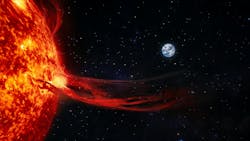AI model Surya helps scientists predict solar storms with greater accuracy
Summary Points:
- Surya is an open-source AI foundation model developed to study and forecast solar activity.
- The project involves collaboration among NASA centers, universities, and private research groups.
- Researchers say the model could help protect Earth's satellites, communications, and power systems.
WASHINGTON - A research team from academia, industry, and the Universities Space Research Association’s Research Institute for Advanced Computer Science (RIACS) has created Surya, an open-source artificial intelligence (AI) foundation model designed to study and predict solar activity.
The model represents an advance in space weather forecasting, which is becoming increasingly vital as solar storms disrupt satellite operations, navigation systems, and power infrastructure. Surya’s architecture enables it to analyze massive amounts of solar data, uncovering the physical processes that drive solar evolution and influence conditions in near-Earth space.
Developed through a collaboration that includes National Aeronautics and Space Administration (NASA) centers, major universities, and private research organizations, Surya applies large-scale machine learning principles similar to those used in natural language processing. The approach brings modern AI techniques to a new frontier - space weather prediction.
Model background
The model was trained on nine years of continuous data from NASA’s Solar Dynamics Observatory, which captures high-resolution images of the Sun every 12 seconds. By learning from this extensive dataset, Surya can recognize complex patterns in solar behavior and forecast key events, such as flares and coronal mass ejections, with greater accuracy. The open-source model also provides a foundation for future research and innovation in solar and heliophysics studies.
USRA’s role focused on model implementation, architecture evaluation, and code review. "Surya represents a paradigm shift in how we study the Sun," said Dr. David Bell, director of USRA’s Research Institute for Advanced Computer Science. "For the first time, we have an AI foundation model that can fundamentally change how we prepare for and respond to space weather events that affect everything from satellites to power grids."
Researchers have already applied Surya to several areas of solar forecasting. The model has shown improved accuracy in predicting the formation of new active regions on the Sun’s surface, forecasting the timing and intensity of solar flares, estimating solar wind speeds, and simulating the Sun’s extreme ultraviolet (EUV) spectral output.
In the past two years, space weather has been linked to the loss of satellites worth tens of millions of dollars due to increased atmospheric drag during solar storms.
Founded in 1969 under the auspices of the National Academy of Sciences at the request of the U.S. government, the Universities Space Research Association is a nonprofit corporation that operates scientific institutes and research programs. The organization works with government, academic, and industry partners to advance space-related science, technology, and engineering.
About the Author

Jamie Whitney
Jamie Whitney joined the staff of Military & Aerospace Electronics and Intelligent Aerospace. He brings seven years of print newspaper experience to the aerospace and defense electronics industry.
Whitney oversees editorial content for the Intelligent Aerospace Website, as well as produce news and features for Military & Aerospace Electronics, attend industry events, produce Webcasts, oversee print production of Military & Aerospace Electronics, and expand the Intelligent Aerospace and Military & Aerospace Electronics franchises with new and innovative content.
